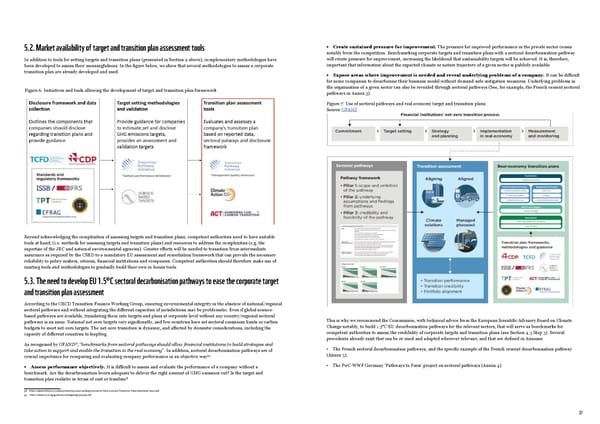27 5.2. Market availability of target and transition plan assessment tools In addition to tools for setting targets and transition plans (presented in Section 2 above), complementary methodologies have been developed to assess their meaningfulness. In the figure below, we show that several methodologies to assess a corporate transition plan are already developed and used. Beyond acknowledging the complexities of assessing targets and transition plans, competent authorities need to have suitable tools at hand, (i.e. methods for assessing targets and transition plans) and resources to address the complexities (e.g. the expertise of the JRC and national environmental agencies). Greater efforts will be needed to transition from intermediate assurance as required by the CSRD to a mandatory EU assessment and remediation framework that can provide the necessary reliability to policy makers, citizens, financial institutions and companies. Competent authorities should therefore make use of existing tools and methodologies to gradually build their own in-house tools. 5.3. The need to develop EU 1.5°C sectoral decarbonisation pathways to ease the corporate target and transition plan assessment According to the OECD Transition Finance Working Group, ensuring environmental integrity in the absence of national/regional sectoral pathways and without integrating the different capacities of jurisdictions may be problematic. Even if global science- based pathways are available, translating them into targets and plans at corporate level without any country/regional sectoral pathways is an issue. National net-zero targets vary significantly, and few countries have set sectoral emissions limits or carbon budgets to meet net-zero targets. The net-zero transition is dynamic, and affected by domestic considerations, including the capacity of different countries to leapfrog. As recognised by GFANZ 58 , “ benchmarks from sectoral pathways should allow financial institutions to build strategies and take action to support and enable the transition in the real economy ”. In addition, sectoral decarbonisation pathways are of crucial importance for comparing and evaluating company performance in an objective way 59 : • Assess performance objectively. It is difficult to assess and evaluate the performance of a company without a benchmark. Are the decarbonisation levers adequate to deliver the right amount of GHG emission cut? Is the target and transition plan realistic in terms of cost or timeline? 58 https://assets.bbhub.io/company/sites/63/2022/09/Expectations-for-Real-economy-Transition-Plans-September-2022.pdf. 59 https://www.oecd.org/governance/budgeting/1902957.pdf. Figure 6: Initiatives and tools allowing the development of target and transition plan framework • Create sustained pressure for improvement. The pressure for improved performance in the private sector comes notably from the competition. Benchmarking corporate targets and transition plans with a sectoral decarbonisation pathway will create pressure for improvement, increasing the likelihood that sustainability targets will be achieved. It is, therefore, important that information about the expected climate or nature trajectory of a given sector is publicly available. • Expose areas where improvement is needed and reveal underlying problems of a company. It can be difficult for some companies to decarbonise their business model without demand-side mitigation measures. Underlying problems in the organisation of a given sector can also be revealed through sectoral pathways (See, for example, the French cement sectoral pathways in Annex 3). This is why we recommend the Commission, with technical advice from the European Scientific Advisory Board on Climate Change notably, to build 1.5°C EU decarbonisation pathways for the relevant sectors, that will serve as benchmarks for competent authorities to assess the credibility of corporate targets and transition plans (see Section 4.3 Step 3). Several precedents already exist that can be re-used and adapted wherever relevant, and that are defined in Annexes: • The French sectoral decarbonisation pathways, and the specific example of the French cement decarbonisation pathway (Annex 3); • The PwC-WWF Germany ‘Pathways to Paris’ project on sectoral pathways (Annex 4). Figure 7: Use of sectoral pathways and real economy target and transition plans Source: GFANZ
 Corporate Sustainability & Transition Plans Page 13 Page 15
Corporate Sustainability & Transition Plans Page 13 Page 15